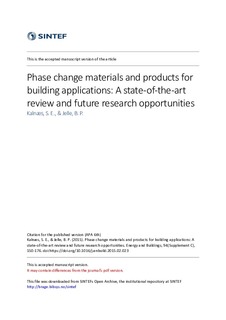| dc.contributor.author | Kalnæs, Simen Edsjø | |
| dc.contributor.author | Jelle, Bjørn Petter | |
| dc.date.accessioned | 2017-12-29T23:27:39Z | |
| dc.date.available | 2017-12-29T23:27:39Z | |
| dc.date.created | 2015-02-08T19:26:51Z | |
| dc.date.issued | 2015 | |
| dc.identifier.citation | Energy and Buildings. 2015, 94 150-176. | nb_NO |
| dc.identifier.issn | 0378-7788 | |
| dc.identifier.uri | http://hdl.handle.net/11250/2473859 | |
| dc.description.abstract | Phase change materials (PCM) have received considerable attention over the last decade for use in latent heat thermal storage (LHTS) systems. PCMs give the ability to store passive solar and other heat gains as latent heat within a specific temperature range, leading to a reduction of energy usage, an increase in thermal comfort by smoothing out temperature fluctuations throughout the day and a reduction and/or shift in peak loads. The interest around PCMs has been growing significantly over the last decade. Hence, several commercial products have arrived on the market with various areas of use in building applications. This study reviews commercial state-of-the-art products found on the market and show some of the potential areas of use for PCMs in building applications. Examples of how PCMs can be integrated into buildings, and furthermore building materials and projects using PCMs that have already been realised, have also been reviewed. There seems to be a scarcity of data published on actual performance in real life applications so far. However, many laboratory and full scale experiments have shown positive results on energy savings. Furthermore, future research opportunities have been explored and challenges with the technology as of today have been discussed. | nb_NO |
| dc.description.sponsorship | This work has been supported by the Research Council of Norway and several partners through The Research Centre on Zero Emission Buildings (ZEB) | nb_NO |
| dc.language.iso | eng | nb_NO |
| dc.publisher | Elsevier | nb_NO |
| dc.rights | Attribution-NonCommercial-NoDerivatives 4.0 Internasjonal | * |
| dc.rights.uri | http://creativecommons.org/licenses/by-nc-nd/4.0/deed.no | * |
| dc.subject | Phase-change material; PCM | nb_NO |
| dc.subject | Energy | nb_NO |
| dc.subject | Buildings | nb_NO |
| dc.subject | State-of-the-art | nb_NO |
| dc.subject | Review | nb_NO |
| dc.subject | Temperature | nb_NO |
| dc.title | Phase Change Materials and Products for Building Applications: A State-of-the-Art Review and Future Research Opportunities | nb_NO |
| dc.type | Journal article | nb_NO |
| dc.type | Peer reviewed | nb_NO |
| dc.description.version | acceptedVersion | nb_NO |
| dc.rights.holder | © 2017 Elsevier B.V. All rights reserved. This is the authors' accepted and refereed manuscript to the article, post-print. Released with a Creative Commons Attribution Non-Commercial No Derivatives License. The final publication is available at https://doi.org/10.1016/j.enbuild.2015.02.023 | nb_NO |
| dc.subject.nsi | VDP::Technology: 500 | nb_NO |
| dc.source.pagenumber | 150-176 | nb_NO |
| dc.source.volume | 94 | nb_NO |
| dc.source.journal | Energy and Buildings | nb_NO |
| dc.identifier.doi | 10.1016/j.enbuild.2015.02.023 | |
| dc.identifier.cristin | 1218650 | |
| dc.relation.project | Norges forskningsråd: 193830 | nb_NO |
| cristin.unitcode | 7401,30,40,0 | |
| cristin.unitname | Arkitektur, byggematerialer og konstruksjoner | |
| cristin.ispublished | true | |
| cristin.fulltext | original | |
| cristin.fulltext | postprint | |
| cristin.qualitycode | 2 | |

